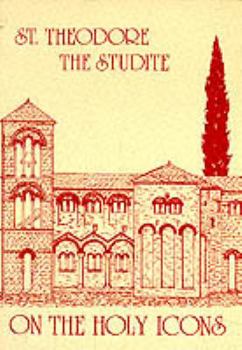Book Overview
To many modern Christians the question of icon veneration may seem a marginal issue in theology. To St Theodore the Studite, writing in the midst of the iconoclastic controversy of the eighth and... This description may be from another edition of this product.
Format:Paperback
Language:English
ISBN:0913836761
ISBN13:9780913836767
Release Date:March 1981
Publisher:St. Vladimir's Seminary Press
Length:115 Pages
Weight:0.30 lbs.
Dimensions:0.4" x 5.1" x 7.3"
Customer Reviews
3 ratings
A serious-minded and faithful work of theology that grappled with a pressing spiritual issue of its
Published by Thriftbooks.com User , 18 years ago
Written by St. Theodore the Studite during the iconoclastic controversy of the eighth-ninth century, On The Holy Icons is a powerful rebuttal of iconoclasm with profound repercussions to the present day. St. Theodore argued passionately that to reject the Christian veneration of images is to deny God's incarnation, which is what makes human salvation possible; to say the Christ cannot be portrayed is to say that He was not truly man, and humanity was not truly united with God in Him. An introduction and a select bibliography round out this enduring text, which is divided into three intense refutation of iconoclasts. A serious-minded and faithful work of theology that grappled with a pressing spiritual issue of its era and truly survives the test of time; very highly recommended for church libraries and theology reference shelves.
Veneration of Icons in Eastern Orthodoxy.
Published by Thriftbooks.com User , 19 years ago
_On the Holy Icons_ by St. Theodore the Studite is an interesting, if extremely dense, treatise defending the Eastern Orthodox tradition of icon veneration. Theodore was a monk from Constantinople who managed several monasteries in the Byzantine Empire during the infamous iconoclast controversy which raged in Byzantium during the eighth and ninth centuries. This English translation (1981) from St. Vladimir's Seminary Press features an introduction by Catherine Roth where she outlines the issues behind the iconoclast controversy and the premises of Theodore's polemics from the side of Orthodoxy. Roth succinctly notes how Theodore "elaborates on the relation of the image to the prototype. The image belongs to the Aristotelian category of relative things, and so it directs the attention from itself to its prototype. The image and the prototype different in essence, but share the same likeness and are called by the same name. Insofar as the image is like its prototype, the prototype may be venerated in the image" (12). This applies to the iconoclast case that the veneration of Orthodox believers to icons is a form of or equivalent to idolatry. If an icon is venerated, Christ is still being worshiped. The actual veneration paid toward the icon is not the same as worship offered to God but an honor and form of high respect to the One who is depicted thereon. Theodore organizes his polemics into three sections. The first section gives an apology for the Orthodox position on icons, defining what exactly is being done when an Orthodox believer venerates an icon. It is similar to the same veneration paid to the sign of the cross, which was maintained by the iconoclasts. Theodore also goes to extreme length in order to prove that the Incarnate Christ was "circumscribable" and thus having the quality to be depicted using physical artistic forms. Christ was a man who lived and walked on earth, was seen by men, wore clothing, ate food and continued to do so even after His resurrection. Therefore, the Incarnate Word was of circumscribable essence and can be pictured with legitimacy. At the end of the first section, Theodore anathematizes as heretics those who deride and condemn the Orthodox veneration of icons. Theodore's second section presents a hypothetical dialogue between a heretic (iconoclast) and an Orthodox on the Biblical and patristic theology behind the issue in question. The third section goes on further to define, using specific examples from the Gospels, of Christ's ability to be circumscribed. Throughout all of the treatises, Theodore also painstakingly differentiates between icon veneration and worship of God. The honor given to the icon is honor given to Christ, and conversely, the dishonor shown toward icons is also a dishonor to Christ. Theodore uses an interesting example of Jews desecrating an icon of Christ in imitation of the sufferings undergone by Christ during His trial and crucifixion. Needless to say, the Mother
The Holy Icons and the Incarnation
Published by Thriftbooks.com User , 23 years ago
C.S. Lewis once wrote on the importance of reading primary sources. This little book is an excellent example of how much reading translations of the early Church fathers can help Christians today. St. Theodore is writing to defend the veneration of the Icons from the second wave of Iconoclasm in the 8th century, in which the iconoclasts had developed a more sophisticated theological attack on the Icons. Theodore the Studite deals with the accusation of idolatry, drawing his defence from the Holy Scriptures. Then he solidly bases the veneration of icons on the Incarnation, saying "He who had created everything became matter (that is, flesh)." He meets the iconoclasts' own arguments, demonstrating that iconoclasts must either be docetists (not believing that the Incarnation was real) or monophysites (Christ's human nature being submerged into His Divinity). He also maintains that Christ is still circumscibable after his Resurrection. While Theodore repeats arguments previously made, such as John of Damascus' distinction between worship and veneration, - saying that we worship only God, but we venerate the images of Christ and His saints, - he also articulates further the connection between the Incarnation and the depiction of Christ in the Icons. Easy to read, this book shows how the veneration of the Icons of Christ and the saints comes directly from an Orthodox understanding of who Christ is and what the incarnation means.




